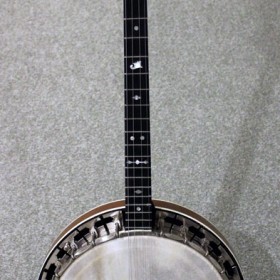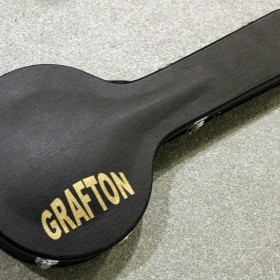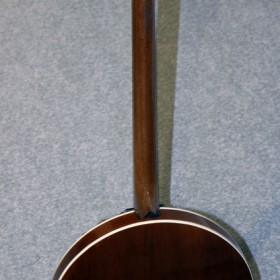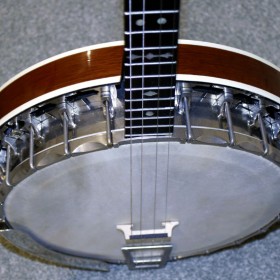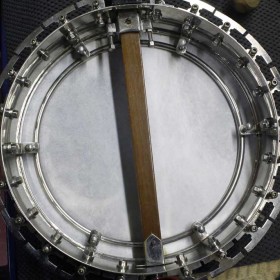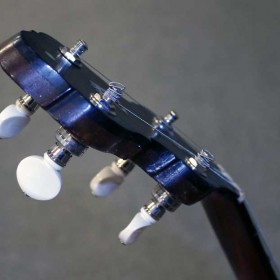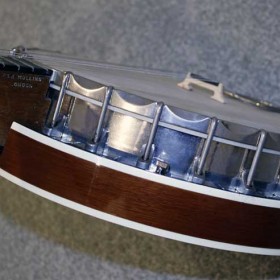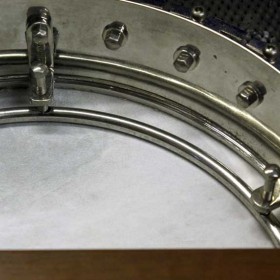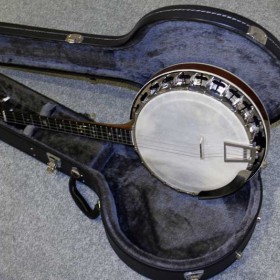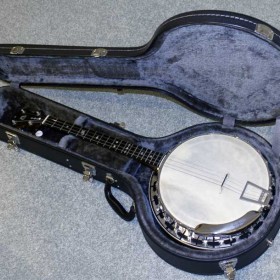Barnes & Mullins (London 1920’s) Vintage Tenor Banjo
Featured
- Mahogany neck with ebony fretboard decorated in mop positions including head stock.
- 19 frets, leveled and polished
- original calf skin head with powerful output volume
- New maple 3 leg bridge with ebony insert.
- Up-graded new planet tuners
- Straight neck with low action.
- Tenor Banjo serial N0.307
The banjo is now sold.
Barnes & Mullins Origins
In 1894, Mr Albert Mullins and Mr S. Bowley Barnes started “The Jo”, their famous musical instrument journal.
Specialising in all things banjo, they soon began manufacturing their own banjos as well as importing many other instruments. The original Barnes and Mullins banjos are still sought after today, with collectors seeking them out all over the world.
Samuel Bowley Barnes and Albert Edward Mullins were both from Dorset although not originally from Bournemouth. Samuel Barnes was born in 1872 in Wimbourne and Albert Mullins was originally from further afield (Somerset or Gloucester) but about the same age. Samuel’s father, Mark was a saddler and harness maker in Corfe Mullen high street. In 1894, they started a journal called “The Jo” specialising in banjos reflecting their interest – they were both players. The name changed to “The Troubadour” later. They moved to London in around 1900 and started a workshop and wholesalers of musical instruments in Rathbone Place, although much of the stock was simply bought in.

Pictured: S. Bowley Barnes & Albert Mullins
Sadly in 1914 at the age of 40, Albert Mullins drowned when the ‘Empress of Ireland’ sank on the St Lawrence River. He was on the home leg of a 2 year sales trip.
Bowley Barnes continued the business thereafter, and what he had started with his partner years earlier in Bournemouth now moved to Rathbone Place, London.
In 1976, Mark Barnes – son of Bowley Barnes – moved the business to Grays Inn Road, Bloomsbury. Sadly in 1986, Mark Barnes died. He was greatly admired and respected by employees and customers alike who were quick to tell of his fair and generous nature.
In 1999, Bruce Perrin – a Director since 1986 – became Managing Director and moved the business from London to the current location – Grays Inn House – a modern 46000sqft warehouse and office facility in Oswestry, Shropshire.
Bruce Perrin says “We are excited about the future and are constantly looking at ways to innovate and evolve, yet Barnes and Mullins has always endeavoured to put the customer at the top of its priority list”.
Present
As of July 2009, Bruce Perrin and former B&M Sales Director Brian Cleary successfully achieved a management buy-out of the Barnes family, bringing the previous 2 years of uncertainty to a positive conclusion. Perrin and Cleary now hold the positions of Joint Managing Directors and are looking forward to the new focus this reformed partnership will bring.
